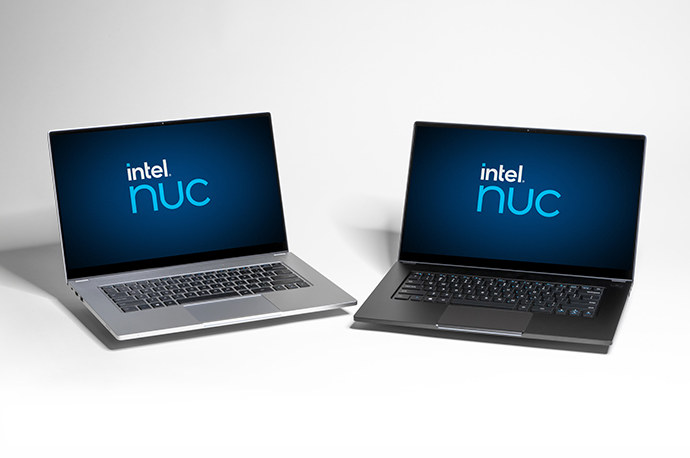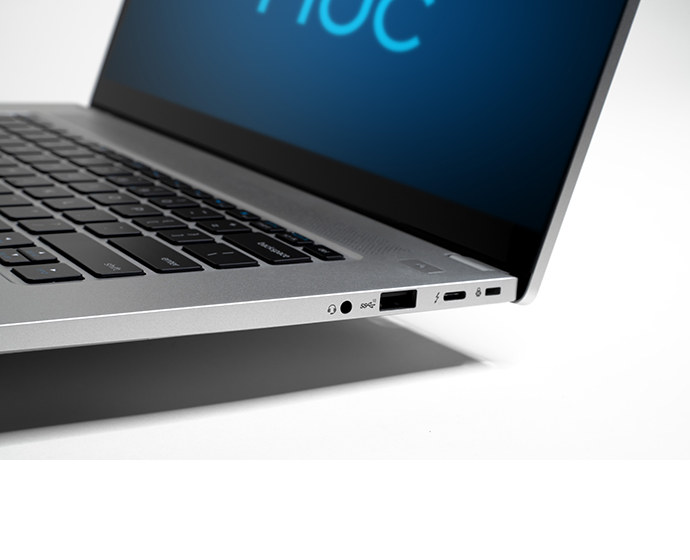Intel NUC mini PCs or mini Desktops have been around for over 8 years, but now Intel has just announced an NUC laptop kit. Wait… What? Yep, NUC just stands for “Next Unit of Computing”, so it can be any kind of computer, and the company’s latest NUC is Intel NUC M15 laptop kit (codenamed “Bishop County”) powered by an Intel 11th generation Tiger Lake processor.
The NUC M15 laptop kit complies with Project Athena that aims for thin laptops with fast response times and long battery life and targets the whitebook market, so Intel customers can use it as a reference design meeting Intel Evo platform brand requirements.
 Intel NUC M15 laptop kit (LAPBC710 and LAPBC510) specifications:
Intel NUC M15 laptop kit (LAPBC710 and LAPBC510) specifications:
- SoC
- LAPBC710 – Intel Core i7-1165G7 quad-core/octa-thread Tiger Lake processor @ up to 2.8 GHz (base) / 4.7 GHz (Turbo single-core) / 4.1 GHz (Turbo all-core) with 12M Cache, 96 EU Intel Iris Xe graphics @ up to 1.30 GHz; TDP: 15-28W
- LAPBC510 – Intel Core i7-1135G7 quad-core/octa-thread Tiger Lake processor @ up to 2.4 GHz (base) / 4.2 GHz (Turbo single-core) / 3.8 GHz (Turbo all-core) with 8MB Cache, 80 EU Intel Iris Xe graphics @ up to 1.30 GHz; TDP: 15-28W
- System Memory
- LAPBC510 – 8GB dual-channel LPDDR4x-4266MHz
- LAPBC710 – 16GB dual-channel LPDDR4x-4266MHz
- Storage – 1x M.2 card slot
- Display – 15.6-inch IPS display with 1,920 x 1,080 resolution
- Video Output- HDMI port
- Audio – 3.5mm audio jack, speakers, microphone
- Camera – Built-in webcam
- Connectivity – 802.11ax WiFI 6 via Intel Wi-Fi 6 AX201 M.2 card
- USB – 2x USB ports
- Thunderbolt – 2x Thunderbolt 4 USB-C ports
- Misc – Kensington lock; user presence detection; fast wake up from sleep under one second
- Battery – 73 Wh battery good for up to 16 hours of video playback; 30 minutes fast charge gives around four hours of battery life
- Dimensions – 355 x 230 x 14.9mm
- Weight – Under 1.7 kg
 Intel only lists Windows 10 operating system for the laptop. The company will not sell the Intel NUC M15 directly to consumers and instead will rely on EVO-approved channel partners such as Acer, ASUS, Dell, Lenovo, HP, and others. The first laptops based on Bishop County design are expected in January 2021.
Intel only lists Windows 10 operating system for the laptop. The company will not sell the Intel NUC M15 directly to consumers and instead will rely on EVO-approved channel partners such as Acer, ASUS, Dell, Lenovo, HP, and others. The first laptops based on Bishop County design are expected in January 2021.
Further information can be found on the press release and Ark.

Jean-Luc started CNX Software in 2010 as a part-time endeavor, before quitting his job as a software engineering manager, and starting to write daily news, and reviews full time later in 2011.
Support CNX Software! Donate via cryptocurrencies, become a Patron on Patreon, or purchase goods on Amazon or Aliexpress. We also use affiliate links in articles to earn commissions if you make a purchase after clicking on those links.






Intel can make an as bad product as you can think of. And still sell everything.
Not that this is bad.
Being no Apple fan what so ever. This suddenly doesn’t seem as compelling anymore.
The future is ARM. (and AMD)
>Intel can make an as bad product as you can think of. And still sell everything.
If you watch the various interviews with other companies that were trying to compete around the pentium era like the one with the 68K guys you see a pattern; Intel didn’t win back then because they had the absolute best chip for the best price. They won because they had technology that was on par or better than everyone else and they had the huge manufacturing capacity and capabilities to push everyone else out of the market.
>Not that this is bad.
>Being no Apple fan what so ever. This suddenly doesn’t seem as compelling anymore.
I have no idea what this has to do with anything to be honest but makes me think the next thing you’re going to write is purely emotional…
>The future is ARM. (and AMD)
Why? See the first paragraph I wrote. Intel isn’t competing with ARM or AMD because instruction sets are irrelevant unless you need to run legacy code. The underlying machine could be SISC for all you care.
They are competing with TSMC as aside from Intel they are the only guys that can actually make modern high performance chips at scale.
It is all about performance/watt. What also brings better thermals, lower power consumption, better battery life, more headroom for performance,…
Intel does have some nice laptop SoC’s, but they are not able to go head to head with ARM or even with AMD in these things.
I don’t doubt they’ll come back strong. They’ve got the capital to do whatever they think is needed.
I do believe Intel will leave their own x86 architecture behind them. Mix of ARM and x86 should/could be first. And later RISC-V intel CPUs.
There is a lot more room for improvements there. x86 is one big mess of layers upon layers of compromises to keep compatibility. It is a true wonder these CPU’s still work the way they do. Thanks to a whole mess of software mitigations.
I’m no fan-boy. But I do see the advantages of ARM-RISC. I’ve been telling about it for years in my videos.
>but they are not able to go head to head with ARM
>or even with AMD in these things.
Again, you’re looking in the wrong place. ARM is a fabless IP company that has been bought out once by the same guys that wasted tons of money on a company that should have made zero sense if they had done their due diligence properly (wework) and is now looking like it might be bought by another company that is a competitor to almost everyone else in the ARM echo system (nvidia). AMD is similar to Intel in that they actually make complete chip designs, get them made into chips and sell them but neither of them can actually make chips you and I can buy without TSMC.
If nvidia buys ARM and takes over TSMC you might have a point. If AMD hadn’t spun out globalfoundries and GF was still in the technology race you might have a point.. but that isn’t the case.
Comparing Intel’s mobile platforms to AMDs makes more sense but you can’t compare “ARM’s mobile platform” because they don’t have one.
>I don’t doubt they’ll come back strong.
>They’ve got the capital to do whatever they think is needed.
Personally I don’t care if they do as long as there is at least one company that sells platforms that aren’t locked down mobile phone/chromebook SoCs.
>I do believe Intel will leave their own x86 architecture behind them.
I’m pretty sure they tried that and had to jump on the 64 bit x86 train because no one really cares about ISAs and just wants their stuff to run. Crazy I know.
>Mix of ARM and x86 should/could be first.
Pssst. Intel already sells ARM chips.
>x86 is one big mess of layers upon layers of
>compromises to keep compatibility.
This comes up here over and over and over again. Let’s say X86 is a massive turd and ARM, RISC-V etc are divine instruction sets were not a single bit is wasted and they bring harmony to the universe at every pipeline stage.
I don’t know about you but my machine runs so many instructions per second that I really couldn’t care how divine they are. If youtube videos of sexy kpop ladies are decoded by divine instructions does it make them sexier, the colours richer or anything?
>It is a true wonder these CPU’s still work the way they do.
>Thanks to a whole mess of software mitigations.
Lets ignore that ARM and just about every other CPU core out there has errata that have to be handled by the OS and almost everyone got caught out by mistakes that made spectre etc possible.
If the CPU works for what you want it do to why do you care? Internal combustion engines are apparently pretty difficult to get right too but do you get in your car, go to turn the key, stop yourself and think “mmm I’m sceptical about this whole internal combustion thing. Despite this car driving me to and from Mc Donalds every day for the last decade suddenly I don’t feel it is capable of traversing the Mc Donald’s drive through. I think I’ll take my electric snowmobile instead.”
>I’m no fan-boy. But I do see the advantages of ARM-RISC.
What about the massive disadvantages? i.e. it takes years before most of an ARM chip works in mainline if ever, it’s next to impossible to get them in a form factor that’s serviceable without throwing away the whole machine etc.
What is “SISC”? I think you meant CISC. Else, do educate us folks.
“The SISC extends the concept of RISC architecture to the fullest degree. Basically, the SISC implements a single, yet extremely powerful, instruction”
Wikipedia etc seem to use OISC instead. Google that if you want to know more I guess.
Thanks. I didn’t know something like this even existed!
SISC, Atari Magazine Vol. 3 No. 9 / April 1989
https://www.atarimagazines.com/startv3n9/sisc.html
Excerpt: “The SISC extends the concept of RISC architecture to the fullest degree. Basically, the SISC implements a single, yet extremely powerful, instruction. The result is a flexible, low-cost processor that outperforms many designs containing tens of thousands more transistors.”